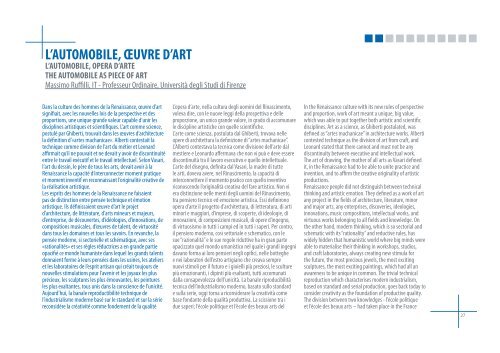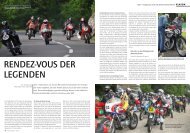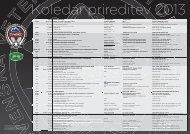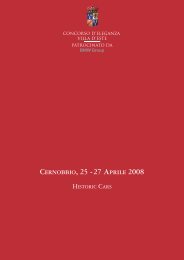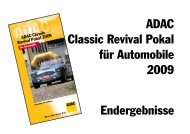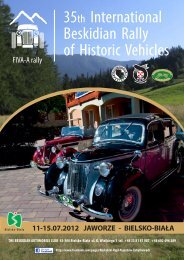Automotoclub Storico Italiano - Fédération Internationale des ...
Automotoclub Storico Italiano - Fédération Internationale des ...
Automotoclub Storico Italiano - Fédération Internationale des ...
Create successful ePaper yourself
Turn your PDF publications into a flip-book with our unique Google optimized e-Paper software.
L’AUTOMOBILE, ŒUVRE D’ART<br />
L’AUTOMOBILE, OPERA D’ARTE<br />
THE AUTOMOBILE AS PIECE OF ART<br />
Massimo Ruffi lli, IT - Professeur Ordinaire, Università degli Studi di Firenze<br />
Dans la culture <strong>des</strong> hommes de la Renaissance, œuvre d’art<br />
signifi ait, avec les nouvelles lois de la perspective et <strong>des</strong><br />
proportions, une unique grande valeur capable d’unir les<br />
disciplines artistiques et scientifi ques. L’art comme science,<br />
postulé par Ghiberti, trouvait dans les œuvres d’architecture<br />
la défi nition d’»artes machanicae». Alberti contestait la<br />
technique comme division de l’art du métier et Leonard<br />
affi rmait qu’il ne pouvait et ne devait y avoir de discontinuité<br />
entre le travail exécutif et le travail intellectuel. Selon Vasari,<br />
l’art du <strong>des</strong>sin, le père de tous les arts, devait avoir à la<br />
Renaissance la capacité d’interconnecter moment pratique<br />
et moment inventif en reconnaissant l’originalité créative de<br />
la réalisation artistique.<br />
Les esprits <strong>des</strong> hommes de la Renaissance ne faisaient<br />
pas de distinction entre pensée technique et émotion<br />
artistique. Ils défi nissaient œuvre d’art le projet<br />
d’architecture, de littérature, d’arts mineurs et majeurs,<br />
d’entreprise, de découvertes, d’idéologies, d’innovations, de<br />
compositions musicales, d’œuvres de talent, de virtuosité<br />
dans tous les domaines et tous les savoirs. En revanche, la<br />
pensée moderne, si sectorielle et schématique, avec ses<br />
«rationalités» et ses règles réductrices a en grande partie<br />
opacifi é ce monde humaniste dans lequel les grands talents<br />
donnaient forme à leurs pensées dans les usines, les ateliers<br />
et les laboratoires de l’esprit artisan qui créait toujours de<br />
nouvelles stimulations pour l’avenir et les joyaux les plus<br />
précieux, les sculptures les plus émouvantes, les peintures<br />
les plus exaltantes, tous unis dans la conscience de l’unicité.<br />
Aujourd’hui, la banale reproductibilité technique de<br />
l’industrialisme moderne basé sur le standard et sur la série<br />
reconsidère la créativité comme fondement de la qualité<br />
L’opera d’arte, nella cultura degli uomini del Rinascimento,<br />
voleva dire, con le nuove leggi della prospettiva e delle<br />
proporzione, un unico grande valore, in grado di accomunare<br />
le discipline artistiche con quelle scientifi che.<br />
L’arte come scienza, postulata dal Ghiberti, trovava nelle<br />
opere di architettura la defi nizione di “artes machanicae”.<br />
L’Alberti contestava la tecnica come divisione dell’arte dal<br />
mestiere e Leonardo aff ermava che non vi può e deve essere<br />
discontinuità tra il lavoro esecutivo e quello intellettuale.<br />
L’arte del disegno, defi nita dal Vasari, la madre di tutte<br />
le arti, doveva avere, nel Rinascimento, la capacità di<br />
interconnettere il momento pratico con quello inventivo<br />
riconoscendo l’originalità creativa del fare artistico. Non vi<br />
era distinzione nelle menti degli uomini del Rinascimento,<br />
tra pensiero tecnico ed emozione artistica. Essi defi nirono<br />
opera d’arte il progetto d’architettura, di letteratura, di arti<br />
minori e maggiori, d’imprese, di scoperte, di ideologie, di<br />
innovazioni, di composizioni musicali, di opere d’ingegno,<br />
di virtuosismo in tutti i campi ed in tutti i saperi. Per contro,<br />
il pensiero moderno, così settoriale e schematico, con le<br />
sue “razionalità” e le sue regole riduttive ha in gran parte<br />
opacizzato quel mondo umanistico nel quale i grandi ingegni<br />
davano forma ai loro pensieri negli opifi ci, nelle botteghe<br />
e nei laboratori dell’estro artigiano che creava sempre<br />
nuovi stimoli per il futuro e i gioielli più preziosi, le sculture<br />
più emozionanti, i dipinti più esaltanti, tutti accomunati<br />
dalla consapevolezza dell’unicità. La banale riproducibilità<br />
tecnica dell’industrialismo moderno, basato sullo standard<br />
e sulla serie, oggi torna a riconsiderare la creatività come<br />
base fondante della qualità produttiva. La scissione tra i<br />
due saperi; l’école politique et l’ècole <strong>des</strong> beaux arts del<br />
In the Renaissance culture with its new rules of perspective<br />
and proportion, work of art meant a unique, big value,<br />
which was able to put together both artistic and scientifi c<br />
disciplines. Art as a science, as Ghiberti postulated, was<br />
defi ned as “artes machanicae” in architecture works. Alberti<br />
contested technique as the division of art from craft, and<br />
Leonard stated that there cannot and must not be any<br />
discontinuity between executive and intellectual work.<br />
The art of drawing, the mother of all arts as Vasari defi ned<br />
it, in the Renaissance had to be able to unite practice and<br />
invention, and to affi rm the creative originality of artistic<br />
productions.<br />
Renaissance people did not distinguish between technical<br />
thinking and artistic emotion. They defi ned as a work of art<br />
any project in the fi elds of architecture, literature, minor<br />
and major arts, any enterprises, discoveries, ideologies,<br />
innovations, music compositions, intellectual works, and<br />
virtuous works belonging to all fi elds and knowledge. On<br />
the other hand, modern thinking, which is so sectorial and<br />
schematic with its “rationality” and reductive rules, has<br />
widely hidden that humanistic world where big minds were<br />
able to materialise their thinking in workshops, studios,<br />
and craft laboratories, always creating new stimula for<br />
the future, the most precious jewels, the most exciting<br />
sculptures, the most exciting paintings, which had all an<br />
awareness to be unique in common. The trivial technical<br />
reproduction which characterises modern industrialism,<br />
based on standard and serial production, goes back today to<br />
consider creativity as the foundation of productive quality.<br />
The division between two knowledges - l’école politique<br />
et l’école <strong>des</strong> beaux arts – had taken place in the France<br />
27


